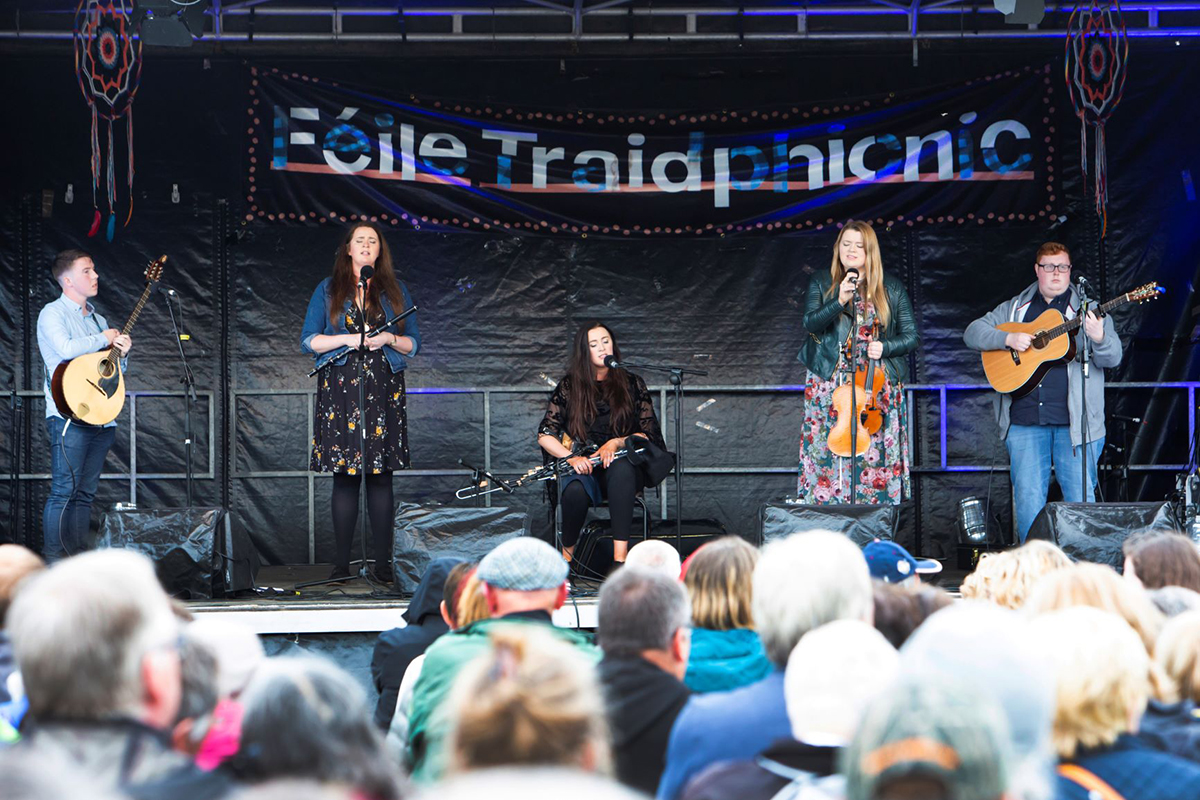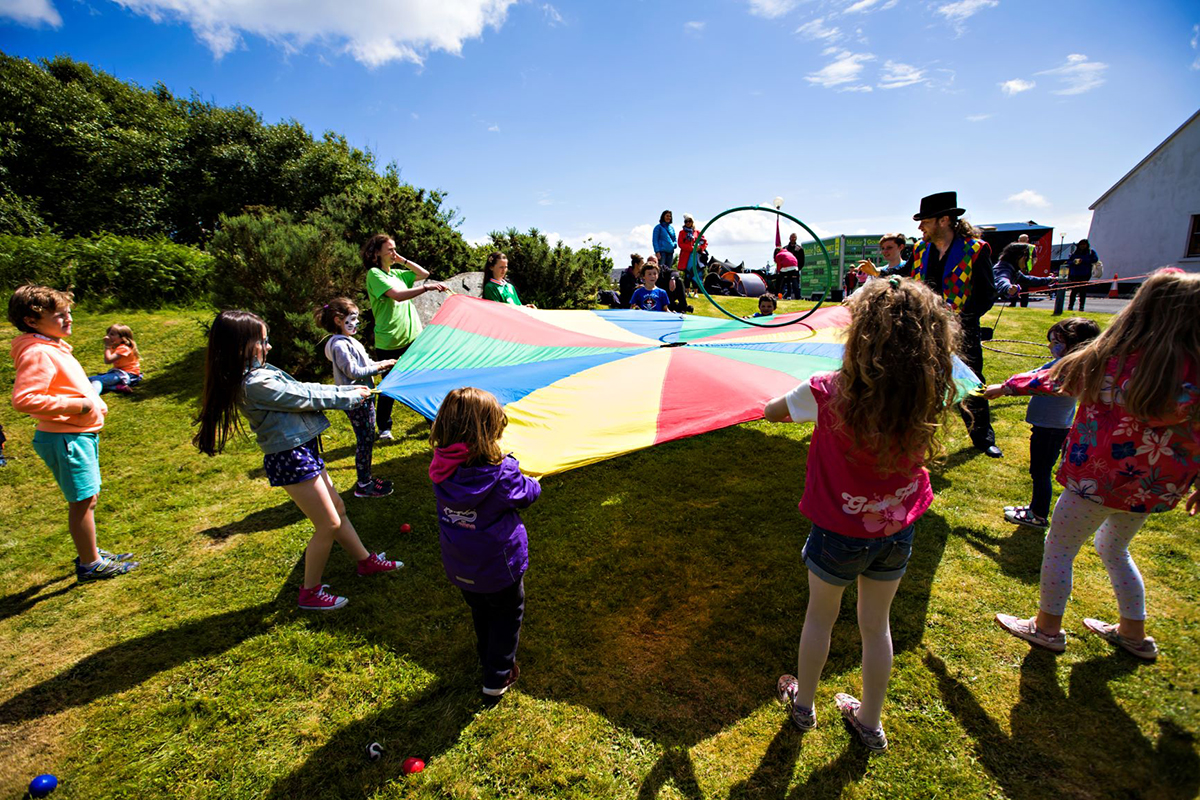
The first Féile Traidphicnic was held in 2012 with an aim of offering a high quality, inclusive, ‘access for all’ festival whilst also celebrating our strong local sean-nós tradition. The programme aims to feature emerging and renowned traditional Irish
musicians, the Irish language and a developing programme of visual arts. The festival is made by its community, for its community and to that end we run a ‘donate what you can’ programme so that as many people as possible have access to, and can enjoy
the arts.
The festival team consists of a voluntary committee: Bridge Barker (who we spoke with for this interview), Sara Howlin, Steve Sweeney and Liam Collins who are local to the area and supported by a number of enthusiastic local supporters and a team of volunteers
The festival is able to run with support from public funders, local sponsors and community fundraisers and benefit in kind.
How has your festival been affected by the COVID-19 health crisis?
We have many new grey hairs from this COVID-19 year! We didn’t have much time to plan. As a result, we had to go with our ‘gut’ feeling along with feedback from artists that
were booked and replies from some of our regular festival goers who all wanted to go ahead and try an on-line edition.
There was no pressure on anyone to perform, but we were amazed at the feedback from artists and their desire to still do something. Not knowing whether what we were planning would work, we went ahead and ran a re-imagined ‘ar líne’ [online] Traidphicnic
within six weeks!
We provided a blended programme of digital live events with social distancing. One example of this being the Traidphicnic Céilí Bus which visited three local nursing homes along the ‘Chois Fharraige’.
The organising of this had its challenges between insurance and COVID protocols. But, it went ahead to a great response. Our volunteer Safety/COVID-19 Officer Mary Owens even realised a life-long dream when she joined the Cogar Céilí band and is now their
unofficial snare drummer - none of us knew she could drum!
After the last nursing home visit we did an ‘old fashioned’ call and asked ‘’An bhfuil sibh sa mbaile? [Are you home?]’’ which resulted in a road side session – with sean-nós dance-offs in the mix. This was captured on Facebook live and we virtually brought
our viewers along with us for the day.
Did digital content play a large part in your festival prior to this crisis?
We are committed to live events primarily. We have recorded some of our more recent festivals through audio and video. These recordings have been used primarily for promotional purposes. We would like to eventually get some support in this area as we
hope to one day create a digital archive.

What are the advantages/disadvantages of presenting work in this way?
In recent years, the way we have digitally presented creative work has not been polished (mainly via mobile phones and live feed) however, we still have received a very good response from our audience. Our online community really loves live feeds and
there is usually a lot of online interaction between viewers, artists and the festivals team during these broadcasted performances. The ability to interact with other audience members and the sense of community that can be created would be the main
advantage of presenting work in this way.
In terms of disadvantages, although digital platforms can create a sense of community it can never really replace the sense of intimacy that comes with the live experience, especially with our “hugs-friendly” festival.
What informed your decision to present creative work through digital means?
Forced by COVID-19, our decision to present work online was a reaction to the limited situation we found ourselves in along with a strong desire to still do something. We decided very early on, with unreliable internet provision resulting in poor quality
live feeds, we wanted to pre-record the festival but try to deliver it with as live a feel as possible. It was then pre-scheduled and delivered as if it was live.
Over the three evenings of the festival [3–5 July, 2020], three concert programmes were delivered. Intros were filmed and video messages were received and edited together with the gigs. The Airdín Buí area of the Traidphicnic, usually a hive of
activity, was re-created and a separate programme was made.
We also produced a digital road trip which took viewers on a virtual journey on which they met with over 40 youngsters along the way and interacted with music, song, dance and poetry coming from the heart of the Conamara Gaeltacht. It was described as
“warm and different’’ and ‘’gave a sense of place and community”.

How did audiences respond?
We have had a great response from audience members with regard to our live feeds and the feedback that we received confirmed that our attempt to deliver pre-recorded footage as if it were live was successful.
We are currently compiling a social media report. During the broadcast of our performances, it felt the number of viewers watching live were disappointingly low. However, after the performances were broadcast the views began to increase, showing that
people came back to view and continue to do so. It’s great that we have this online festival now that can be interacted with at any time.
Having said that, in terms of our live interactions with audiences, there was also an amazing response. The joy on the faces that the music brought to the residents and staff of the local nursing homes we visited will stay with us all forever and highlight
the importance of music, song and dance in everyone's life.
Regardless of whatever restrictions are in place, do you think that your 2020 programme will inform what you plan for 2021?
Who knows what lies ahead? We feel that we adapted well – it was a very challenging time, but on a positive note, a lot of new skills were obtained along the way.
We hope that by July 2021 we will be able to deliver a live Traidphicnic. We have invited all artists that were due to participate at Traidphicnic 2020 —funding pending— to perform live with us next year.
We will have to see what lies ahead. We will reassess and adapt to the situation in the best way we can.

What would you say was your biggest takeaway from the 2020 iteration of the festival?
Lots of lessons learnt and new skills gained. It took a lot to pull everything together and it was stressful at times. It was no mean feat within a 6 week turnaround to re-act, re-imagine, think outside the box and deliver the digital Féile Traidphicnic
whilst still managing to reach out to include and interact as much as possible within our physical community (within COVID restrictions) along with our online community. The loneliness of watching the live stream on your own home does not replace
the real thing, but feels good knowing we did our best and we now have a lovely reminder, or captured a time capsule of the COVID times that we find ourselves in.
All programmes are available to view on Traidphicnic YouTube channel and Féile Traidphicnic Facebook page
For more information on the Tradphicnic Festival, please visit tradpicnic.com